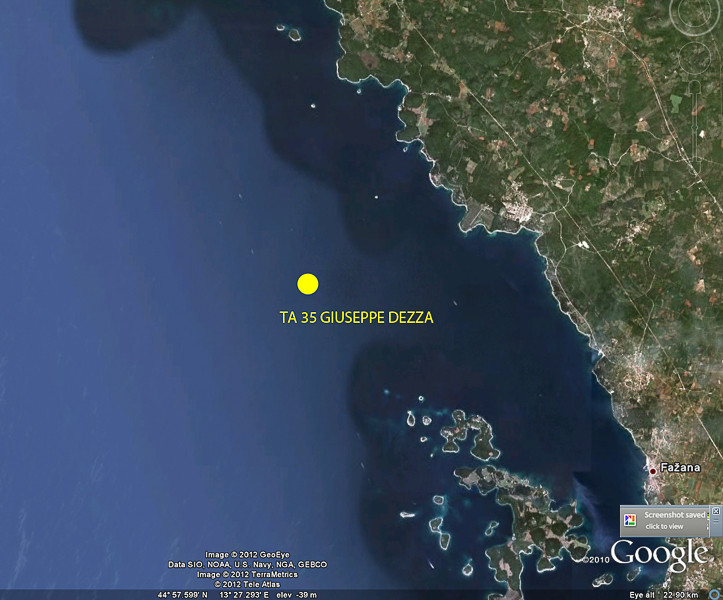
TA 35 GIUSEPPE DEZZA
DEPTH: 22 - 30 m
SKILL: Advanced
TA 35 (ex-Giuseppe Dezza, ex-Pilade Bronzetti); escort destroyer (torpedo boat), Pilo class; German Navy
Built: keel 1913, launched 26th October 1915, completed 15th December 1915, Cantieri N. Odero & Co. Sestri Ponente, Genoa, entered German service 9th June 1944
Sunk: 17th August 1944 (hit a mine)
Dimensions: l=73 m, w=7.33 m, draught=2.46 m, displacement 672
Coordinates: 44.97247˚ N, 13.67408˚ E
Location: close to the Fažana Channel
Access: 2/5 access is solely by boat (the location is in the open sea)
Visibility: 3/5 highly variable, occasionally exceptional
Current : 3/5 moderate
Flora and fauna: 4/5 varied life on and around the wreck, occasionally specimens of large fish
HISTORY:
The TA 35 Giuseppe Dezza was a torpedo boat of the Pilo class. They were modern fast destroyers 73 m long, 7.33 m wide with a draught 2.46 m. The fuel for the steam boilers was oil, at that time a real novelty in respect of the classic fuel - coal. They were able to achieve an enviable speed of 32 knots, and had an autonomous range of 1,440 miles at an economical speed. The basic concept of these ships proved to be so successful, that besides these first eight another 17 of this type of ship were built.
In the mid-1920s the Pilo destroyer class had become outdated, and so all the Pilo class ships were re-categorised as torpedo boats and assigned auxiliary duties. With the outbreak of the Second World War they were all re-activated, and the majority of them would disappear in the vortex of the greatest war in history.
After the Allied landings on Sicily in 1943, the Dezza was moved to Rijeka for repairs. The Italian capitulation on 9th September 1943 found the ship in Rijeka, when on 11th September, incapable of navigation it was captured by the Germans. After long-lasting repairs and remodelling, on 9th June 1944 it entered German service under the sign TA 35 and it performed the task of following convoys along the Dalmatian coast. However its service with the German Navy (Kriegsmarine) did not last long. On 17th August 1944 near to the Brijuni Islands is came across an anchored mine. The tremendous explosion tore the ship into two parts, which sank in just a few minutes. Along with the ship 71 crew members perished.
WRECK CONDITION AND DIVING:
The dive to the TA 35 is blue, as with all of the Istrian wrecks. Above it is an anchored buoy which enables us to descend right to the stern of the wreck. With good visibility the stern can be seen from a depth of ten or so metres and it is lovely to see the curved top of the stern and side shields above the propeller. With good visibility the experience is outstanding, because at a few metres below us the whole ship can be seen, more precisely two thirds of the ship, because it is cut short somewhere just behind the bridge. We descend next to the rear 102 mm gun, where the anchor rope is tied with a buoy. Swimming along we arrive at the base of one anti-aircraft gun which can be seen close by, taking care not to touch the deck with our flippers as the stirring up of silt will in an instant reduce the visibility to half a metre. On the base is a four-barrelled German 20 mm calibre gun – the popular “flak”, the barrels of which are pointing straight up. A little further on the ventilation openings of the engine room can be seen. Along the flank of the ship can also be seen one torpedo tube which as fallen from its stand on the deck. Several metres further along on the deck lies one more inverted gun pedestal. Not far from the gun we come across the point where the ship has been split. The steel plating looks as though some giant has torn and crumpled it. Amid this disarray lies a large steam boiler which had miraculously remained in tact after the explosion. At the bottom there is a layer of silty water, which prevents us from peeking into the interior of this part of the ship.
For the same reason we give up looking for the stern part of the ship, which lies about a hundred metres away. A special dive would need to be devoted to reach it. It is best that we turn back, passing again next to the rear gun and continuing towards the stern. We come across a circular opening, through which we can see the stairs which lead below decks. The opening is too narrow to squeeze through with the bottles on our backs, but inside can be seen some kind of corridor half-full of silt and several doors. We descend down the stern to the propellers, which are half-buried in the mud. The visibility is so poor that we immediately return towards the deck. We pass by the rudder, which on this type of ship is a really peculiar shape, as it is attached at the end of the stern from the outside, like on some kind of small sailing boat. Due to such an arrangement it was an Achilles heel for this class of torpedo boat because the rudder mechanism very often failed, and at critical battle moments causing real panic amongst the crews.
We return to the aft deck and we look at the rear gun once more before surfacing. Next to the gun is the mechanism of the auxiliary steering gear, which could control the ship in the case that the bridge was disabled in battle. Although the rudder wheel is missing, still here are the gears which were connected to the rudder with steel cables. We end the diving by starting for the surface following the anchored rope.
The description and illustrations are a courtesy of Danijel Frka and Jasen Mesić. Buy the whole book here: https://shop.naklada-val.hr/product_info.php?products_id=561
Built: keel 1913, launched 26th October 1915, completed 15th December 1915, Cantieri N. Odero & Co. Sestri Ponente, Genoa, entered German service 9th June 1944
Sunk: 17th August 1944 (hit a mine)
Dimensions: l=73 m, w=7.33 m, draught=2.46 m, displacement 672
Coordinates: 44.97247˚ N, 13.67408˚ E
Location: close to the Fažana Channel
Access: 2/5 access is solely by boat (the location is in the open sea)
Visibility: 3/5 highly variable, occasionally exceptional
Current : 3/5 moderate
Flora and fauna: 4/5 varied life on and around the wreck, occasionally specimens of large fish
HISTORY:
The TA 35 Giuseppe Dezza was a torpedo boat of the Pilo class. They were modern fast destroyers 73 m long, 7.33 m wide with a draught 2.46 m. The fuel for the steam boilers was oil, at that time a real novelty in respect of the classic fuel - coal. They were able to achieve an enviable speed of 32 knots, and had an autonomous range of 1,440 miles at an economical speed. The basic concept of these ships proved to be so successful, that besides these first eight another 17 of this type of ship were built.
In the mid-1920s the Pilo destroyer class had become outdated, and so all the Pilo class ships were re-categorised as torpedo boats and assigned auxiliary duties. With the outbreak of the Second World War they were all re-activated, and the majority of them would disappear in the vortex of the greatest war in history.
After the Allied landings on Sicily in 1943, the Dezza was moved to Rijeka for repairs. The Italian capitulation on 9th September 1943 found the ship in Rijeka, when on 11th September, incapable of navigation it was captured by the Germans. After long-lasting repairs and remodelling, on 9th June 1944 it entered German service under the sign TA 35 and it performed the task of following convoys along the Dalmatian coast. However its service with the German Navy (Kriegsmarine) did not last long. On 17th August 1944 near to the Brijuni Islands is came across an anchored mine. The tremendous explosion tore the ship into two parts, which sank in just a few minutes. Along with the ship 71 crew members perished.
WRECK CONDITION AND DIVING:
The dive to the TA 35 is blue, as with all of the Istrian wrecks. Above it is an anchored buoy which enables us to descend right to the stern of the wreck. With good visibility the stern can be seen from a depth of ten or so metres and it is lovely to see the curved top of the stern and side shields above the propeller. With good visibility the experience is outstanding, because at a few metres below us the whole ship can be seen, more precisely two thirds of the ship, because it is cut short somewhere just behind the bridge. We descend next to the rear 102 mm gun, where the anchor rope is tied with a buoy. Swimming along we arrive at the base of one anti-aircraft gun which can be seen close by, taking care not to touch the deck with our flippers as the stirring up of silt will in an instant reduce the visibility to half a metre. On the base is a four-barrelled German 20 mm calibre gun – the popular “flak”, the barrels of which are pointing straight up. A little further on the ventilation openings of the engine room can be seen. Along the flank of the ship can also be seen one torpedo tube which as fallen from its stand on the deck. Several metres further along on the deck lies one more inverted gun pedestal. Not far from the gun we come across the point where the ship has been split. The steel plating looks as though some giant has torn and crumpled it. Amid this disarray lies a large steam boiler which had miraculously remained in tact after the explosion. At the bottom there is a layer of silty water, which prevents us from peeking into the interior of this part of the ship.
For the same reason we give up looking for the stern part of the ship, which lies about a hundred metres away. A special dive would need to be devoted to reach it. It is best that we turn back, passing again next to the rear gun and continuing towards the stern. We come across a circular opening, through which we can see the stairs which lead below decks. The opening is too narrow to squeeze through with the bottles on our backs, but inside can be seen some kind of corridor half-full of silt and several doors. We descend down the stern to the propellers, which are half-buried in the mud. The visibility is so poor that we immediately return towards the deck. We pass by the rudder, which on this type of ship is a really peculiar shape, as it is attached at the end of the stern from the outside, like on some kind of small sailing boat. Due to such an arrangement it was an Achilles heel for this class of torpedo boat because the rudder mechanism very often failed, and at critical battle moments causing real panic amongst the crews.
We return to the aft deck and we look at the rear gun once more before surfacing. Next to the gun is the mechanism of the auxiliary steering gear, which could control the ship in the case that the bridge was disabled in battle. Although the rudder wheel is missing, still here are the gears which were connected to the rudder with steel cables. We end the diving by starting for the surface following the anchored rope.
The description and illustrations are a courtesy of Danijel Frka and Jasen Mesić. Buy the whole book here: https://shop.naklada-val.hr/product_info.php?products_id=561







 The investment is co-financed by the Republic of Slovenia and the European Union from the European Regional Development Fund.
The investment is co-financed by the Republic of Slovenia and the European Union from the European Regional Development Fund.  H2O Globe BETA
H2O Globe BETA